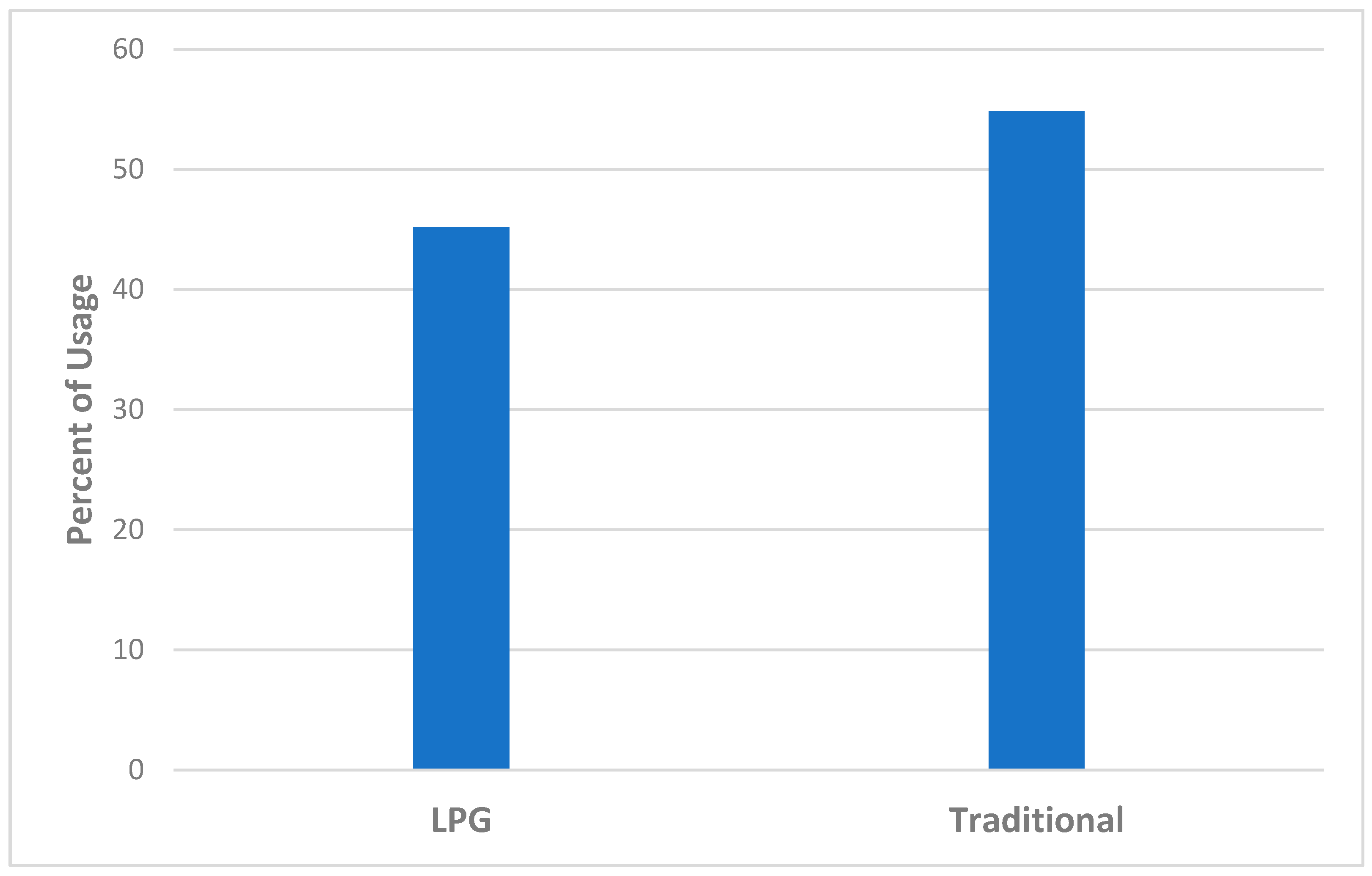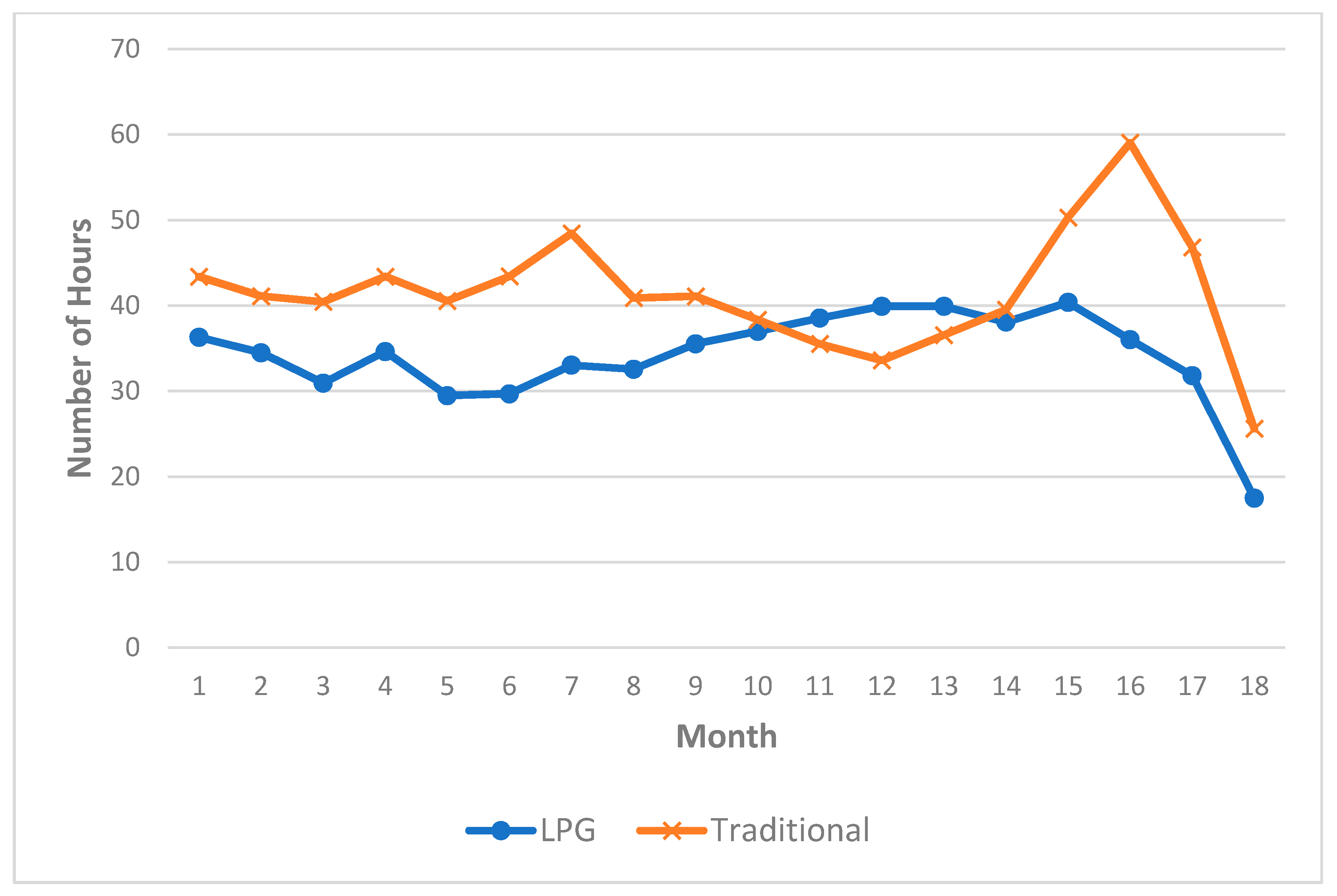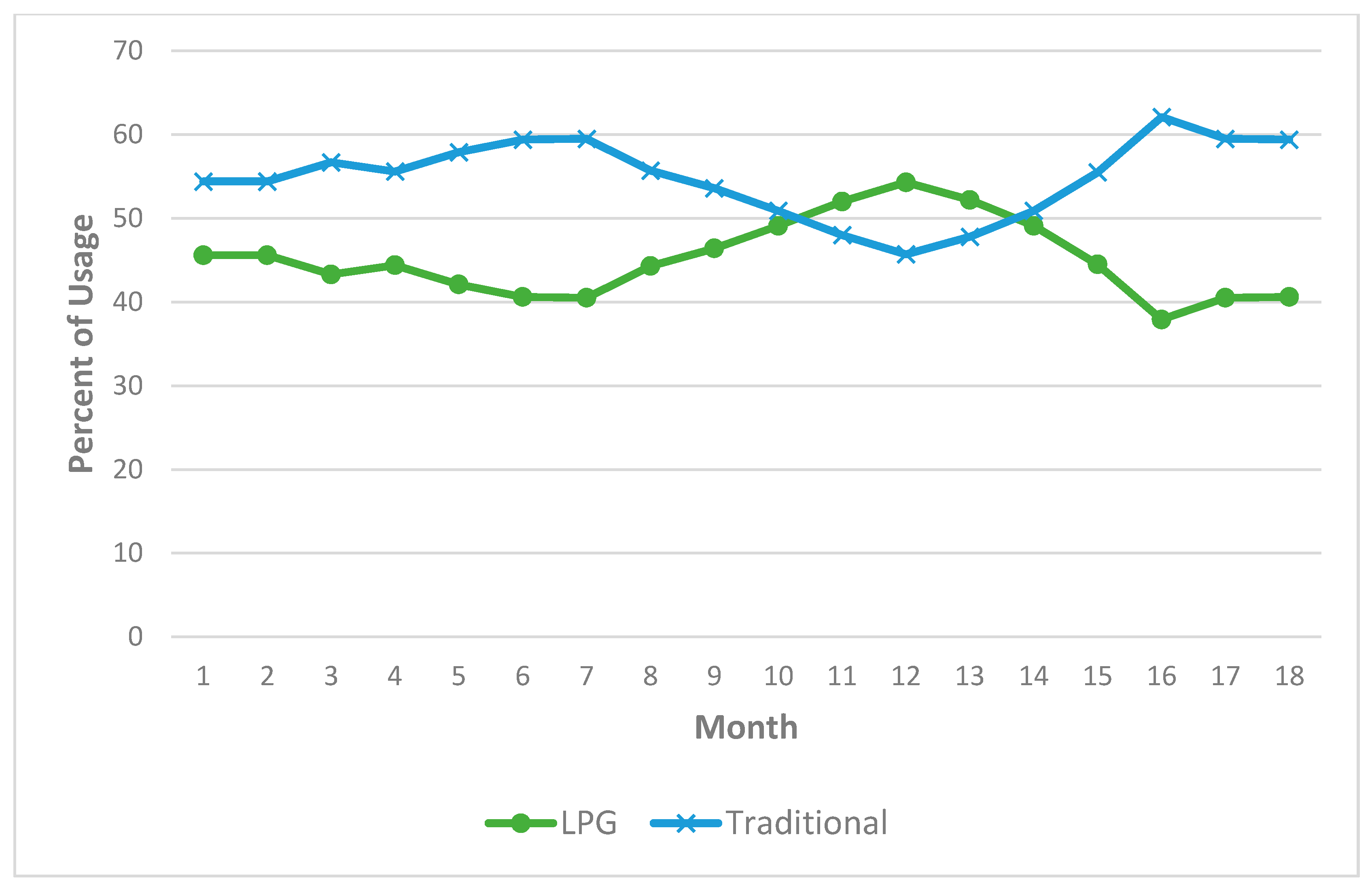Characterizing Sustained Use of Cleaner Cooking Fuel in Rural Poor Households of South India
Abstract
:1. Introduction
1.1. Research Gap
1.2. Study Objectives
2. Methods
2.1. Operationalization of Variables
2.1.1. Outcome Variable
2.1.2. Predictors
- Refill cost: Recent literature indicates that LPG refill cost impacts the extent of LPG use in rural poor households of India. Households that could afford higher refills might be more likely to use LPG, other factors remaining constant. We collected data on average refill cost from each sample household at the baseline, midline, and endline.
- Fuel contributing to less choking: We explored the perception of women (primary respondent) on LPG relative to traditional biomass use in terms of which fuel, they felt, contributes to less choking during cooking.
- Fuel releasing less smoke: We explored the perception of women (primary respondent) on LPG relative to traditional biomass use in terms of which fuel, they felt, releases less smoke during cooking.
- Fuel helping in faster cooking: We explored the perception of women (primary respondent) on LPG relative to traditional biomass use in terms of which fuel, they felt, helped in faster cooking of food.
- LPG refill tank transportation: A filled LPG tank weighs approximately 29.5 KGs (65 pounds). Transportation of such heavy LPG tanks could be an essential accessibility factor determining consistent use. We explored the LPG tank delivery logistics to sample households with three options: (1) delivered to households by the LPG distribution agency; (2) self-delivery arranged by households in owned vehicle; and (3) self-delivery arranged by households in a hired vehicle.
2.1.3. Control Variables
2.2. Data Analyses
3. Results
4. Discussion
4.1. Research Objective 1: Stacking
4.2. Research Objective 2: Correlates of Proportion of LPG Use
4.3. Implications for Future Research, Strategies, and Policy
- Using technologies like SUMS provides accurate evidence on stove usage in the wake of significant investment in clean cooking policies. Improvement in user-behavior knowledge by deploying SUMS provides granularity in uncovering the efficacy of clean cooking social policies and programs. Social workers and policy makers should continue engaging with technologists to deepen their efforts to design and develop human-centered technology applications to improve understanding of the behavior of energy-poor communities in resource-constrained areas.
- The study uncovers that attitudes and perceptions of poor communities toward LPG, and by extension toward cleaner cooking systems, matter. The findings highlight the need for further research to engage in targeted community-based awareness and educational campaigns regarding the benefits of clean cooking. Cooking is both a highly culturized and a personal activity influenced by internal and external factors. Adequate understanding and routine application of the person-in-environment perspective makes the social and policy researchers uniquely positioned in challenges on clean cooking. They can better understand the individual, relational, and environmental (both natural and built) factors that could expedite or impede the extent of clean cooking use in poor communities.
- The study, though exploratory, provides a robust idea on the current usage levels of LPG and traditional stoves, and the significance of supporting infrastructure. The findings could be leveraged to inform policy makers to develop logistical support an infrastructure to ensure timely delivery of LPG tanks to these households.
- The study uncovers the importance of attitudes and perceptions on clean cooking in poor communities. This calls for the policy makers to further empathize on targeted awareness campaigns to promote the utility and benefits of clean cooking in these communities.
5. Limitations of the Manuscript
6. Conclusions
Author Contributions
Funding
Institutional Review Board Statement
Informed Consent Statement
Data Availability Statement
Acknowledgments
Conflicts of Interest
References
- Bonjour, S.; Adair-Rohani, H.; Wolf, J.; Bruce, N.G.; Mehta, S.; Prüss-Ustün, A.; Lahiff, M.; Rehfuess, E.A.; Mishra, V.; Smith, K.R. Solid fuel use for household cooking: Country and regional estimates for 1980–2010. Environ. Health Perspect. 2013, 121, 784–790. [Google Scholar] [CrossRef] [PubMed] [Green Version]
- Balmes, J.R. Household air pollution from domestic combustion of solid fuels and health. J. Allergy Clin. Immunol. 2019, 143, 1979–1987. [Google Scholar] [CrossRef] [PubMed]
- Landrigan, P.J. Air pollution and health. Lancet Public Health 2017, 2, e4–e5. [Google Scholar] [CrossRef] [Green Version]
- Simkovich, S.; Goodman, D.; Roa, C.; Crocker, M.E.; Gianella, G.E.; Kirenga, B.J.; Wise, R.; Checkley, W. The health and social implications of household air pollution and respiratory diseases. NPJ Prim. Care Respir. Med. 2019, 29, 1–17. [Google Scholar] [CrossRef]
- Dionisio, K.L.; Howie, S.R.C.; Dominici, F.; Fornace, K.; Spengler, J.D.; Donkor, S.; Chimah, O.; Oluwalana, C.; Ideh, R.C.; Ebruke, B.; et al. The exposure of infants and children to carbon monoxide from biomass fuels in The Gambia: A measurement and modeling study. J. Expo. Sci. Environ. Epidemiol. 2012, 22, 173–181. [Google Scholar] [CrossRef] [Green Version]
- Balakrishnan, K.; Dey, S.; Gupta, T.; Dhaliwal, R.S.; Brauer, M.; Cohen, A.J.; Stanaway, J.; Beig, G.; Joshi, T.K.; Aggarwal, A.N.; et al. The impact of air pollution on deaths, disease burden, and life expectancy across the states of India: The Global Burden of Disease Study 2017. Lancet Planet. Health 2019, 3, e26–e39. [Google Scholar] [CrossRef] [Green Version]
- Pandey, A.; Brauer, M.; Cropper, M.L.; Balakrishnan, K.; Mathur, P.; Dey, S.; Turkgulu, B.; Kumar, G.A.; Khare, M.; Beig, G.; et al. Health and economic impact of air pollution in the states of India: The Global Burden of Disease Study 2019. Lancet Planet. Health 2021, 5, e25–e38. [Google Scholar] [CrossRef]
- Ruiz-Mercado, I.; Masera, O. Patterns of stove use in the context of fuel–device stacking: Rationale and implications. EcoHealth 2015, 12, 42–56. [Google Scholar] [CrossRef]
- Aggarwal, S.; Kumar, S.; Tiwari, M.K. Decision support system for Pradhan Mantri Ujjwala Yojana. Energy Policy 2018, 118, 455–461. [Google Scholar] [CrossRef]
- Mhamia, A. Pradhan Mantri Ujjwala Yojana—A Giant Step Towards Better Life for All. 2016. Available online: http://pib.nic.in/newsite/printrelease.aspx?relid=148971 (accessed on 14 December 2021).
- Sharma, A.; Parikh, J.; Singh, C. Transition to LPG for cooking: A case study from two states of India. Energy Sustain. Dev. 2019, 51, 63–72. [Google Scholar] [CrossRef]
- Gould, C.; Urpelainen, J. LPG as a clean cooking fuel: Adoption, use, and impact in rural India. Energy Policy 2018, 122, 395–408. [Google Scholar] [CrossRef] [PubMed]
- Kumar, P.; Dover, R.E.; Iriarte, A.D.-V.; Rao, S.; Garakani, R.; Hadingham, S.; Dhand, A.; Tabak, R.G.; Brownson, R.C.; Yadama, G.N. Affordability, accessibility, and awareness in the adoption of liquefied petroleum gas: A case-control study in rural India. Sustainability 2020, 12, 4790. [Google Scholar] [CrossRef]
- Srinivasan, S.; Carattini, S. Adding fuel to fire? Social spillovers in the adoption of LPG in India. Ecol. Econ. 2020, 167, 106398. [Google Scholar]
- Kumar, P.; Dhand, A.; Tabak, R.G.; Brownson, R.C.; Yadama, G.N. Adoption and sustained use of cleaner cooking fuels in rural India: A case control study protocol to understand household, network, and organizational drivers. Arch. Public Health 2017, 75, 1–11. [Google Scholar] [CrossRef] [PubMed] [Green Version]
- Berkeley Air Monitoring Group. Stove Performance Inventory Report; Berkeley Air Monitoring Group: Berkeley, CA, USA, 2012. [Google Scholar]
- Ruiz-Mercado, I.; Canuz, E.; Walker, J.L.; Smith, K.R. Quantitative metrics of stove adoption using Stove Use Monitors (SUMs). Biomass-Bioenergy 2013, 57, 136–148. [Google Scholar] [CrossRef] [Green Version]
- Lewis, J.J.; Pattanayak, S.K. Who adopts improved fuels and cookstoves? A systematic review. Environ. Health Perspect. 2012, 120, 637–645. [Google Scholar] [CrossRef]
- Bhojvaid, V.; Jeuland, M.; Kar, A.; Lewis, J.J.; Pattanayak, S.K.; Ramanathan, N.; Ramanathan, V.; Rehman, I.H. How do people in rural India perceive improved stoves and clean fuel? Evidence from Uttar Pradesh and Uttarakhand. Int. J. Environ. Res. Public Health 2014, 11, 1341. [Google Scholar] [CrossRef]
- Cheng, C.-Y.; Urpelainen, J. Fuel stacking in India: Changes in the cooking and lighting mix, 1987–2010. Energy 2014, 76, 306–317. [Google Scholar] [CrossRef]
- Malakar, Y. Studying household decision-making context and cooking fuel transition in rural India. Energy Sustain. Dev. 2018, 43, 68–74. [Google Scholar] [CrossRef]
- Pillarisetti, A.; Ghorpade, M.; Madhav, S.; Dhongade, A.; Roy, S.; Balakrishnan, K.; Sankar, S.; Patil, R.; Levine, D.I.; Juvekar, S.; et al. Promoting LPG usage during pregnancy: A pilot study in rural Maharashtra, India. Environ. Int. 2019, 127, 540–549. [Google Scholar] [CrossRef]
- Tripathi, A.; Sagar, A.D.; Smith, K.R. Promoting clean and affordable cooking. Econ. Political Wkly. 2015, 50, 81. [Google Scholar]
- Williams, K.N.; Kephart, J.L.; Del Rio, M.F.; Condori, L.; Koehler, K.; Moulton, L.H.; Checkley, W.; Harvey, S.A. Beyond cost: Exploring fuel choices and the socio-cultural dynamics of liquefied petroleum gas stove adoption in Peru. Energy Res. Soc. Sci. 2020, 66, 101591. [Google Scholar] [CrossRef] [PubMed]
- Abdulai, M.A.; Afari-Asiedu, S.; Carrion, D.; Ae-Ngibise, K.A.; Gyaase, S.; Mohammed, M.; Agyei, O.; Boamah-Kaali, E.; Tawiah, T.; Dwommoh, R.; et al. Experiences with the mass distribution of LPG stoves in rural communities of Ghana. EcoHealth 2018, 15, 757–767. [Google Scholar] [CrossRef] [PubMed]
- Rehman, I.H.; Malhotra, P.; Pal, R.C.; Singh, P.B. Availability of kerosene to rural households: A case study from India. Energy Policy 2005, 33, 2165–2174. [Google Scholar] [CrossRef]
- Kar, A.; Pachauri, S.; Bailis, R.; Zerriffi, H. Using sales data to assess cooking gas adoption and the impact of India’s Ujjwala programme in rural Karnataka. Nat. Energy 2019, 4, 806–814. [Google Scholar] [CrossRef]
- Beltramo, T.; Blalock, G.; Levine, D.I.; Simons, A. Does peer use influence adoption of efficient cookstoves? Evidence from a randomized controlled trial in Uganda. J. Health Commun. 2015, 20, 55–66. [Google Scholar] [CrossRef] [Green Version]



| Variable | Baseline | Midline (9 Months) | Endline (18 Months) | |||
|---|---|---|---|---|---|---|
| Mean (SD) | % (n) | Mean (SD) | % (n) | Mean (SD) | % (n) | |
| Proportion of LPG use | 0.46 (0.28) | 0.46 (0.28) | 0.41 (0.33) | |||
| Refill cost (INR) | 612.76 (89.38) | 749.5 (85.62) | 798.04 (58.82) | |||
| Fuel results in less choking | ||||||
| LPG | 100.00 (62) | 70.00 (42) | 98.28 (57) | |||
| Biomass | 0.00 (0) | 30.00 (18) | 1.72 (1) | |||
| Fuel emits less smoke | ||||||
| LPG | 96.67 (58) | 100.00 (57) | ||||
| Biomass | 3.33 (2) | 0.00 (0) | ||||
| Fuel results in faster cooking | ||||||
| LPG | 98.39 (61) | 95 (57) | 96.55 (56) | |||
| Biomass | 1.61 (1) | 5.00 (3) | 3.45 (2) | |||
| Way LPG refill tank transportation | ||||||
| LPG agency home delivery | 85.48 (53) | 96.67 (58) | 96.36 (53) | |||
| Self-delivery in owned vehicle | 1.61 (1) | 0.00 (0) | 1.82 (1) | |||
| Households arrange self-delivery | 12.90 (8) | 3.33 (20 | 1.82 (1) | |||
| Monthly income (INR) | 1162.30 (1018.89) | |||||
| Regularity of income during the past nine months | ||||||
| Regular across all season | 3.28 (2) | 18.33 (11) | 0.00 (0) | |||
| Fluctuated with each season | 96.72 (59) | 81.67 (49) | 100.00 (53) | |||
| Caste of the respondent | ||||||
| General | 25.81 (16) | |||||
| OBC | 67.74 (42) | |||||
| SC/ST | 4.84 (3) | |||||
| Other religious minorities | 1.61 (1) | |||||
| Variables | Coefficient (SE) | 95% CI |
|---|---|---|
| Affordability | ||
| Refill cost (INR) | 0.00 * (0.00) | [0.00, 0.00] |
| Awareness | ||
| Less choking (LPG is reference category) | −0.10 t (0.06) | [−0.23, 0.03] |
| Less emissions (LPG is reference category) | −0.21 t (0.11) | [−0.43, 0.02] |
| Faster cooking (LPG is reference category) | −0.12 ** (0.04) | [−0.21, −0.04] |
| Accessibility | ||
| Refill transportation (LPG agency home delivery and self-delivery in owned car combined are reference category) | 0.22 * (0.11) | [0.01, 0.43] |
| Control variables | ||
| Regularity of income (regular is reference category) | −0.17 t (0.10) | [−0.37, 0.04] |
| Monthly income (INR) | 0.00 (0.00) | [−0.00, 0.00] |
| Caste (general is reference category) | ||
| OBC | −0.19 * (0.08) | [−0.35, −0.03] |
| SC/ ST | −0.17 * (0.08) | [−0.32, −0.02] |
| Other religious minorities | −0.12 (0.08) | [−0.28, 0.04] |
| Intercept | 0.32 (0.24) | [−0.14, 0.78] |
| ICC | 0.26 | |
| N time-person | 91 | |
| N respondents | 58 | |
Publisher’s Note: MDPI stays neutral with regard to jurisdictional claims in published maps and institutional affiliations. |
© 2022 by the authors. Licensee MDPI, Basel, Switzerland. This article is an open access article distributed under the terms and conditions of the Creative Commons Attribution (CC BY) license (https://creativecommons.org/licenses/by/4.0/).
Share and Cite
Kumar, P.; Du, M.; Ma, M. Characterizing Sustained Use of Cleaner Cooking Fuel in Rural Poor Households of South India. Earth 2022, 3, 313-323. https://doi.org/10.3390/earth3010019
Kumar P, Du M, Ma M. Characterizing Sustained Use of Cleaner Cooking Fuel in Rural Poor Households of South India. Earth. 2022; 3(1):313-323. https://doi.org/10.3390/earth3010019
Chicago/Turabian StyleKumar, Praveen, Maritha Du, and Mingyue Ma. 2022. "Characterizing Sustained Use of Cleaner Cooking Fuel in Rural Poor Households of South India" Earth 3, no. 1: 313-323. https://doi.org/10.3390/earth3010019
APA StyleKumar, P., Du, M., & Ma, M. (2022). Characterizing Sustained Use of Cleaner Cooking Fuel in Rural Poor Households of South India. Earth, 3(1), 313-323. https://doi.org/10.3390/earth3010019







